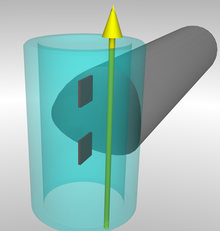Transepidermal water loss
The trans-epidermal water loss , as TEWL for English transepidermal water loss abbreviated, is the measure of the rate of diffusion of water vapor through the dermis of humans, animals or plants. It measures the specific mass flow of water vapor per area and unit of time through the skin. The TEWL is usually given in units of g / m² / h or µg / mm² / h. The measurement of the TEWL is a common method used in dermatological research to characterize the membrane function of the skin.
Specific technical terms for transepidermal water loss are used for individual regions of the human epidermis. Thus the loss of water and nails is as Transonychialer water loss - abbreviated TOWL - called.
Measurement of the TEWL

The measurement of the TEWL was first described by Nilsson in 1977. To measure the TEWL, he proposed an arrangement of two sensors each for relative humidity and temperature in a tube open on both sides. Since the pairs of sensors are arranged at different distances from the skin, they determine the difference in concentration of water vapor and the temperature difference within the tube. From this the diffusion rate can be determined with the formulas described by Nilsson. The measurement of a single TEWL value takes around 10 to 20 seconds after the probe is placed on the skin. This is due to the diffusion speed of water vapor in the air of around 1 mm / s. In the diffusion tube of the TEWL probe, which is typically approx. 20 mm long, a diffusion equilibrium is established after a maximum of 20 seconds and the measured value can be read reliably.
The figure shows the series of measurements from a TEWL measuring instrument. It consists of 24 individual measurements over a period of 12 minutes. Since the measurement was recorded in a warm environment at 27 ° C, the basic level of 30 g / m² / h was relatively high. From minute 2 you can clearly see the reaction of the skin to a hot flash of the test subject, during which the TEWL almost doubles. The hot flash subsides by minute 6. From minute 9 a second minor hot flash follows.
Application of the TEWL
The TEWL correlates both with the barrier function of the skin and with its current condition. It is influenced, among other things, by cosmetics, environmental factors, age, skin type and room climate as well as body functions such as sweating, but also by emotions. Therefore, a strict protocol is followed during studies, with periods of rest before measurements and taking measurements in a relaxed environment. Typical values of the TEWL on healthy skin are between 2.3 g / m² / h on the chest and 44.0 g / m² / h in the armpits. Older people consistently show lower values. Scar tissue typically has very high TEWL values of over 50 or even over 100 g / m² / h.
In the cosmetics industry, the TEWL is used to assess the influence of cosmetics on the condition of the skin. In occupational medicine, this can be used to check the integrity of the skin function in connection with harmful environmental factors.
During the two ESA experiments Skin-Care (2006) and Skin-B (2015 to 2016) on the ISS, the skin condition of the astronauts was continuously examined. Among other things, the transepidermal water loss was determined for this purpose. The data will be used to create an aging model of the skin under space conditions.
literature
- ↑ Helen Alexander, Sara Brown, Simon Danby, Carsten Flohr: Research Techniques Made Simple: Transepidermal Water Loss Measurement as a Research Tool , 2018, doi : 10.1016 / j.jid.2018.09.001
- ↑ Krönauer C., Gfesser M., Ring J., Abeck D .: Transonychial water loss in healthy and diseased nails. Acta Derm Venereol. (2001) 81 (3): 175-177. doi : 10.1080 / 000155501750376249
- ^ A b G. E. Nilsson: Measurement of water exchange through skin. Medical and Biological Engineering and Computing, 1977, N. 15, pp. 209-218, doi : 10.1007 / BF02441040
- ↑ Enzo Berardesca, Marie Loden, Jorgen Serup, Philippe Masson, Luis Monteiro Rodrigues: The revised EEMCO guidance for the in vivo measurement of water in the skin . In: Skin Res Technol. No. 24 . John Wiley & Sons Ltd., January 1, 2018, p. 351-358 , doi : 10.1111 / srt.12599 .
- ↑ a b Jan Kottner, Andrea Lichterfeld, Ulrike Blume-Peytavi: Transepidermal water loss in young and aged healthy humans: a systematic review and meta-analysis . In: Arch Dermatol Res . No. 305 , January 1, 2013, p. 315-323 , doi : 10.1007 / s00403-012-1313-6 .
- ^ KL Gardien, DC Baas, HC de Vet, E. Middelkoop: Transepidermal water loss measured with the Tewameter TM300 in burn scars. Burns (2016) 42 (7): 1455-1462, doi : 10.1016 / j.burns.2016.04.018
- ^ Skin-B experiment. Space Station Research Explorer on NASA.gov, accessed August 7, 2020 .
- ↑ * Video by Alexander Gerst who determines his transepidermal water loss during an experiment in the International Space Station. European Space Agency, accessed August 7, 2020 .
- ↑ Theek C, Tronnier H, Heinrich U, Braun N., Surface Evaluation of Living Skin (SELS) parameter correlation analysis using data taken from astronauts working under extreme conditions of microgravity. Skin Research and Technology. Jan. 2020; 26 (1): 105-111, doi : 10.1111 / srt.12771
